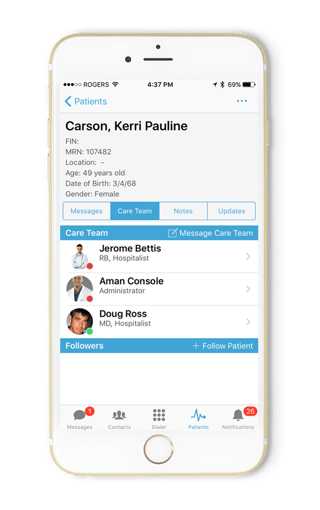Hospital communication has undergone a major revolution in the past few years. From deskbound phones to pagers to smartphones. For many years, it looked like secure text messaging was the holy grail of hospital communication, able to reduce inpatient time and hospital costs while improving patient care. Today, secure texting is failing hospitals. It’s time to think bigger. To think differently. To put the patient first.
80% of serious medical errors involve miscommunications during the hand-off between medical providers.
The Rise of Secure Texting
With the growth in personal mobility, it wasn’t long before smartphones were introduced to the healthcare environment, either corporate-owned or BYOD. Smartphones held obvious benefits over paging systems, allowing for the care team to more quickly co-ordinate and mobilize patient care. Unfortunately, the use of SMS messaging for care co-ordination was both a HIPAA-violation and introduced a level of risk in care delivery, with no visibility over whether messages were delivered or read.
Today, many hospitals have addressed these issues by implementing secure text messaging solutions that provide end-to-end data security with strict data retention policies and message delivery tracking. Many of these solutions have additional integrations that simplify communication workflows. There are many obvious benefits of secure texting, with our own data showing the average healthcare organization saves 84 minutes per physician per day by adopting secure texting.
Why Secure Texting is Failing Hospitals
With these obvious savings and compliance improvements, it seems incongruous to suggest that secure texting is failing. And yet it is. In our webinar, we talked above five areas where secure texting is failing and how we’ve tried to address them here at Telmediq. It’s our ability to address these five major deficiencies in secure texting that have allowed us to evolve into a true communications and workflow platform.
- Poor Reliability - network coverage and data issues, battery life and message delay all contribute to frustrations with secure texting solutions. Investing in networks is key, but message reliability can only be achieved with continuous delivery attempts, alternate modes of delivery and escalation rules. Visibility and automation allow for truly reliable healthcare communication.
- Low User Adoption - resistance to change, coupled with reliability issues, can lead to low user adoption. You don’t want to force yet another solution onto users, you want to streamline or replace inefficient workflows or systems with an integrated, easy-to-use solution
- Lack of User Inclusion - many point solutions fail because they only do one thing or only address one user group (i.e. nurses or physicians). The ideal solution will support the entire care team with role-based integrations, acting as a hub that ties together existing communication tools instead of becoming yet another siloed solution
- Lack of Structure and Policy - secure messages sent to the wrong person don’t streamline care. Physicians don’t want to receive messages when they’re not on call or when receptionists can better handle certain types of requests. Integration with scheduling, on-call platforms and the EMR, combined with structured messaging, routing policies and escalation rules, helps ensure that messages go to the right person at the right time with all the information needed to co-ordinate care.
- Lack of Integration - traditional communication platforms do not have a central workflow around the patient and lack integration with the EMR. Putting the patient in the center of the workflow, allowing the entire care team to communicate about the patient in a manner that ties in with existing infrastructure, helps streamline workflow, improve efficiency and reduce error.
Moving Beyond Secure Texting
 While secure messaging applications originally arose to harness mobile capabilities in healthcare and plug HIPAA compliance gaps, few solutions have evolved beyond encrypted messaging—and the cost to organizations is adding up. As more and more data-producing systems come online, the urgency to harness the power of healthcare data is increasing. It’s not just about notification overload, it’s about system overload. There are simply too many systems to interact with in healthcare.
While secure messaging applications originally arose to harness mobile capabilities in healthcare and plug HIPAA compliance gaps, few solutions have evolved beyond encrypted messaging—and the cost to organizations is adding up. As more and more data-producing systems come online, the urgency to harness the power of healthcare data is increasing. It’s not just about notification overload, it’s about system overload. There are simply too many systems to interact with in healthcare.
In healthcare, the buzz word of 2017 has to be “interoperability”. In an industry where every system creates its own flow of potentially useful data, the path forward is an integrated one. Truly transformative healthcare requires shifting from this siloed approach to healthcare systems and solutions to a patient-centered approach to communication and workflow.
Why Physicians and Nurses Should Be Texting by Melissa Walton-Shirley, MD represents a level of frustration with communication rules and systems that very obviously get in the way of patient care. At Telmediq, we recognize that the role of technology should be to simplify and to automate communication and workflows that get in the way of patient care.
The Telmediq Healthcare Communication Hub was created to enable real-time communication among the care team, but its true power comes by tying together the data flows from disparate systems into a cohesive whole, helping contribute to a complete patient story available to the whole care team. Unlock the potential of your healthcare systems to create a patient-centred approach to healthcare communications. Let us walk you through a demo so you can see for yourself.


